Evidence Based Practice in Nursing: A Position Statement Analysis
VerifiedAdded on 2020/05/04
|7
|1917
|68
Essay
AI Summary
This essay provides a position statement on evidence-based practice (EBP) in nursing, highlighting its significance as a key practice standard for registered nurses, as defined by the Nursing & Midwifery Board of Australia (NMBA). The essay emphasizes the benefits of EBP, such as improved patient outcomes, standardized healthcare practices, and increased patient satisfaction. It also addresses the challenges in implementing EBP, including the gap between theoretical knowledge and practical application, cultural influences, and the need for robust training programs for the nursing workforce. The author argues that despite the challenges, EBP is a revolutionary step toward better healthcare, and overcoming these challenges requires proper training and support for nurses to effectively incorporate research-based techniques into their everyday practice. The essay references several studies to support its arguments and concludes with a call for action to prioritize EBP training to ensure its successful integration into clinical settings.
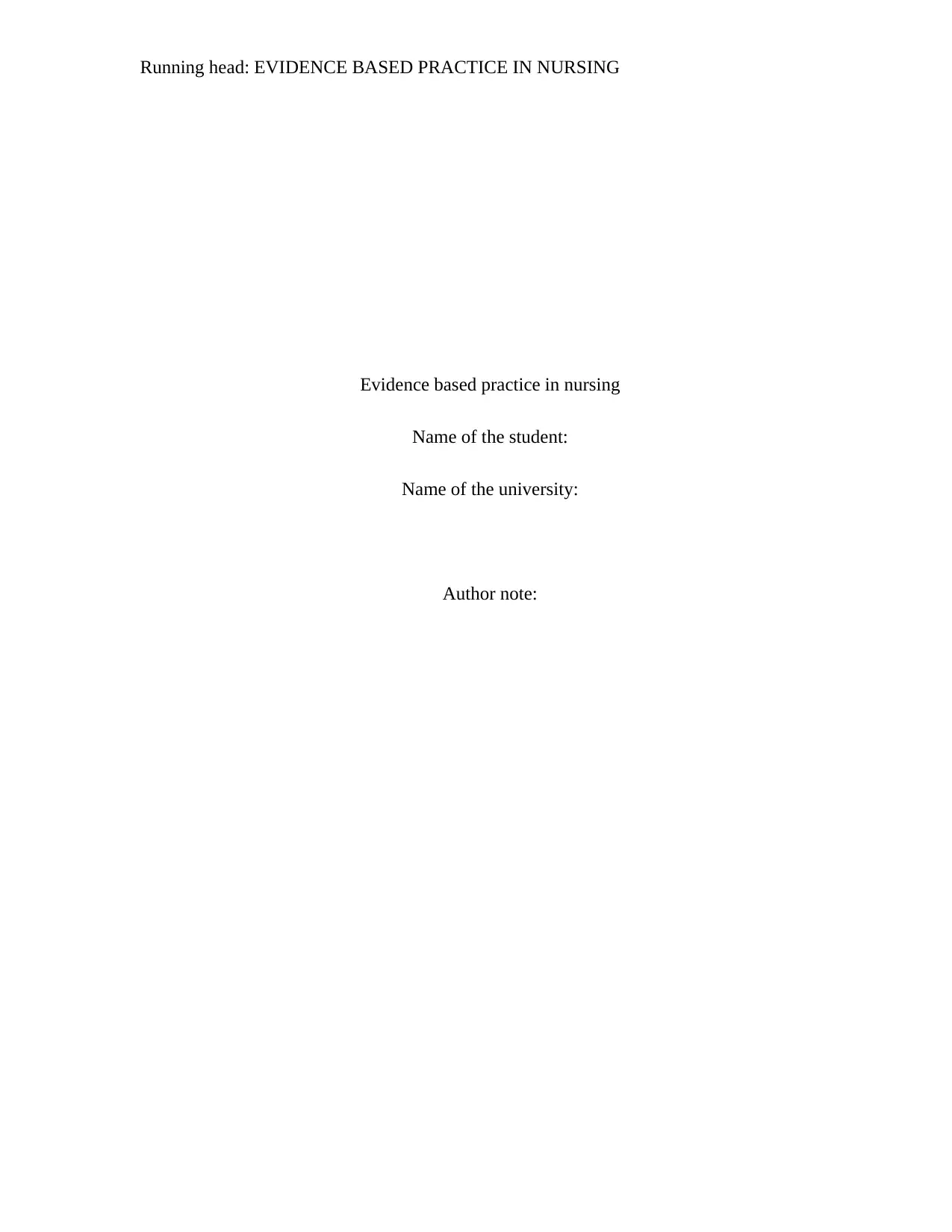
Running head: EVIDENCE BASED PRACTICE IN NURSING
Evidence based practice in nursing
Name of the student:
Name of the university:
Author note:
Evidence based practice in nursing
Name of the student:
Name of the university:
Author note:
Paraphrase This Document
Need a fresh take? Get an instant paraphrase of this document with our AI Paraphraser
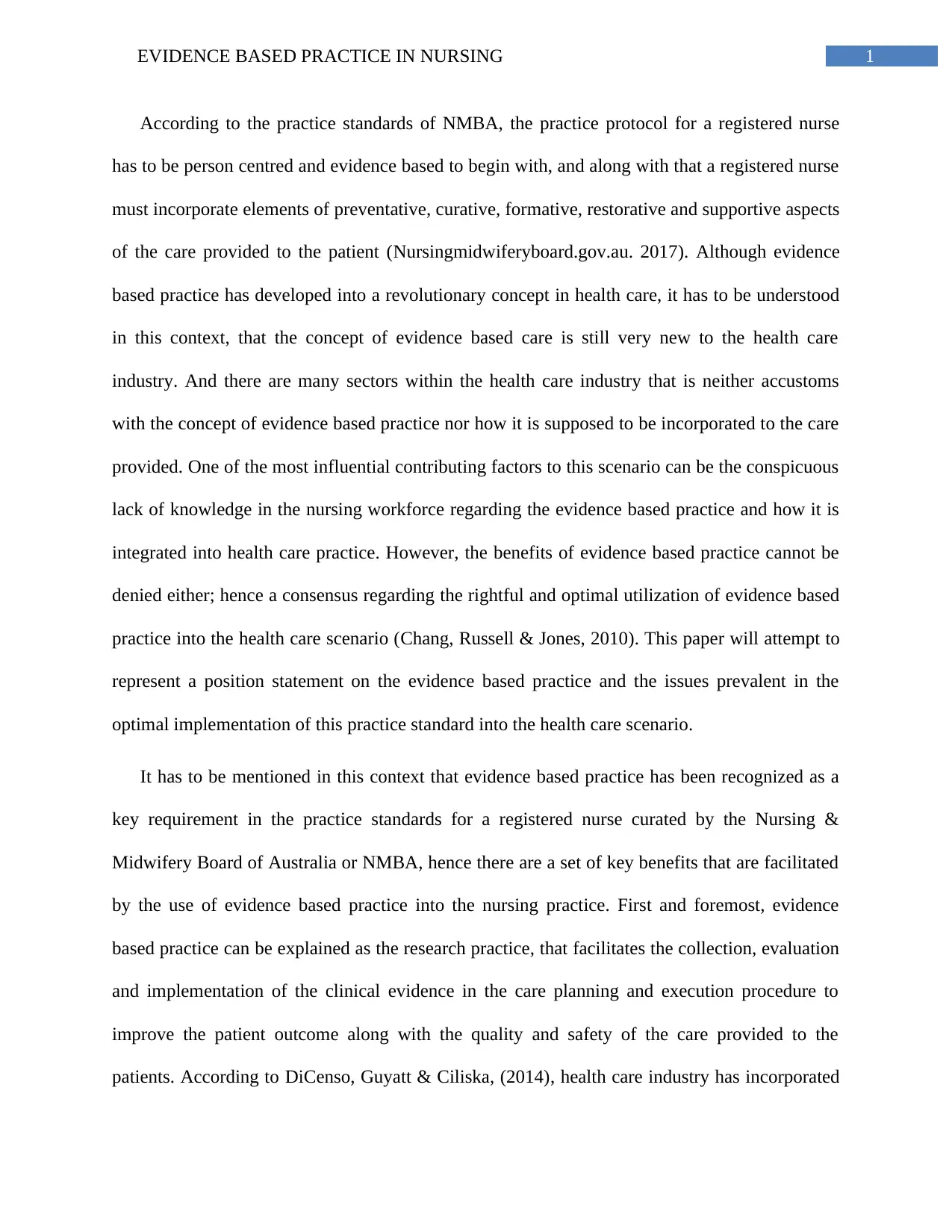
1EVIDENCE BASED PRACTICE IN NURSING
According to the practice standards of NMBA, the practice protocol for a registered nurse
has to be person centred and evidence based to begin with, and along with that a registered nurse
must incorporate elements of preventative, curative, formative, restorative and supportive aspects
of the care provided to the patient (Nursingmidwiferyboard.gov.au. 2017). Although evidence
based practice has developed into a revolutionary concept in health care, it has to be understood
in this context, that the concept of evidence based care is still very new to the health care
industry. And there are many sectors within the health care industry that is neither accustoms
with the concept of evidence based practice nor how it is supposed to be incorporated to the care
provided. One of the most influential contributing factors to this scenario can be the conspicuous
lack of knowledge in the nursing workforce regarding the evidence based practice and how it is
integrated into health care practice. However, the benefits of evidence based practice cannot be
denied either; hence a consensus regarding the rightful and optimal utilization of evidence based
practice into the health care scenario (Chang, Russell & Jones, 2010). This paper will attempt to
represent a position statement on the evidence based practice and the issues prevalent in the
optimal implementation of this practice standard into the health care scenario.
It has to be mentioned in this context that evidence based practice has been recognized as a
key requirement in the practice standards for a registered nurse curated by the Nursing &
Midwifery Board of Australia or NMBA, hence there are a set of key benefits that are facilitated
by the use of evidence based practice into the nursing practice. First and foremost, evidence
based practice can be explained as the research practice, that facilitates the collection, evaluation
and implementation of the clinical evidence in the care planning and execution procedure to
improve the patient outcome along with the quality and safety of the care provided to the
patients. According to DiCenso, Guyatt & Ciliska, (2014), health care industry has incorporated
According to the practice standards of NMBA, the practice protocol for a registered nurse
has to be person centred and evidence based to begin with, and along with that a registered nurse
must incorporate elements of preventative, curative, formative, restorative and supportive aspects
of the care provided to the patient (Nursingmidwiferyboard.gov.au. 2017). Although evidence
based practice has developed into a revolutionary concept in health care, it has to be understood
in this context, that the concept of evidence based care is still very new to the health care
industry. And there are many sectors within the health care industry that is neither accustoms
with the concept of evidence based practice nor how it is supposed to be incorporated to the care
provided. One of the most influential contributing factors to this scenario can be the conspicuous
lack of knowledge in the nursing workforce regarding the evidence based practice and how it is
integrated into health care practice. However, the benefits of evidence based practice cannot be
denied either; hence a consensus regarding the rightful and optimal utilization of evidence based
practice into the health care scenario (Chang, Russell & Jones, 2010). This paper will attempt to
represent a position statement on the evidence based practice and the issues prevalent in the
optimal implementation of this practice standard into the health care scenario.
It has to be mentioned in this context that evidence based practice has been recognized as a
key requirement in the practice standards for a registered nurse curated by the Nursing &
Midwifery Board of Australia or NMBA, hence there are a set of key benefits that are facilitated
by the use of evidence based practice into the nursing practice. First and foremost, evidence
based practice can be explained as the research practice, that facilitates the collection, evaluation
and implementation of the clinical evidence in the care planning and execution procedure to
improve the patient outcome along with the quality and safety of the care provided to the
patients. According to DiCenso, Guyatt & Ciliska, (2014), health care industry has incorporated
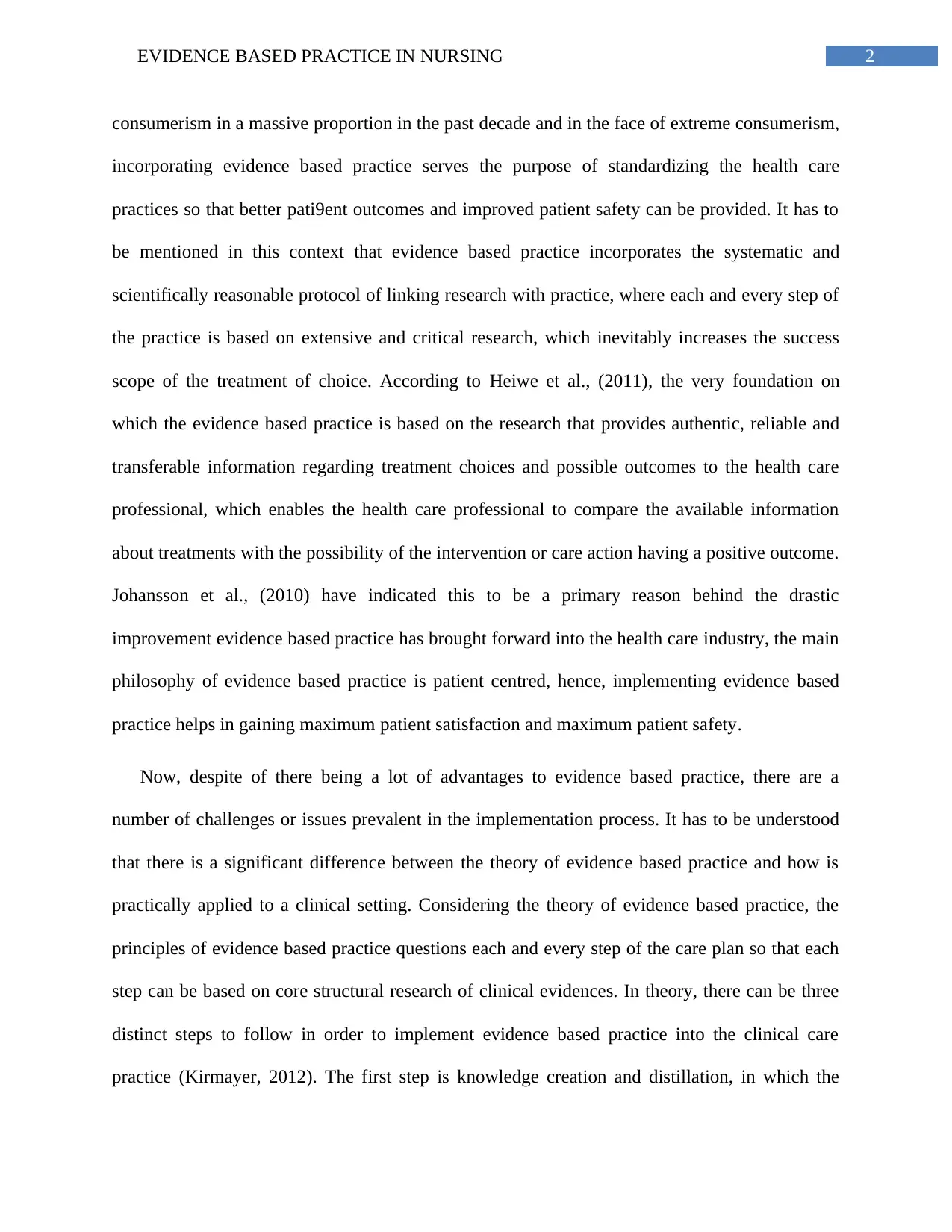
2EVIDENCE BASED PRACTICE IN NURSING
consumerism in a massive proportion in the past decade and in the face of extreme consumerism,
incorporating evidence based practice serves the purpose of standardizing the health care
practices so that better pati9ent outcomes and improved patient safety can be provided. It has to
be mentioned in this context that evidence based practice incorporates the systematic and
scientifically reasonable protocol of linking research with practice, where each and every step of
the practice is based on extensive and critical research, which inevitably increases the success
scope of the treatment of choice. According to Heiwe et al., (2011), the very foundation on
which the evidence based practice is based on the research that provides authentic, reliable and
transferable information regarding treatment choices and possible outcomes to the health care
professional, which enables the health care professional to compare the available information
about treatments with the possibility of the intervention or care action having a positive outcome.
Johansson et al., (2010) have indicated this to be a primary reason behind the drastic
improvement evidence based practice has brought forward into the health care industry, the main
philosophy of evidence based practice is patient centred, hence, implementing evidence based
practice helps in gaining maximum patient satisfaction and maximum patient safety.
Now, despite of there being a lot of advantages to evidence based practice, there are a
number of challenges or issues prevalent in the implementation process. It has to be understood
that there is a significant difference between the theory of evidence based practice and how is
practically applied to a clinical setting. Considering the theory of evidence based practice, the
principles of evidence based practice questions each and every step of the care plan so that each
step can be based on core structural research of clinical evidences. In theory, there can be three
distinct steps to follow in order to implement evidence based practice into the clinical care
practice (Kirmayer, 2012). The first step is knowledge creation and distillation, in which the
consumerism in a massive proportion in the past decade and in the face of extreme consumerism,
incorporating evidence based practice serves the purpose of standardizing the health care
practices so that better pati9ent outcomes and improved patient safety can be provided. It has to
be mentioned in this context that evidence based practice incorporates the systematic and
scientifically reasonable protocol of linking research with practice, where each and every step of
the practice is based on extensive and critical research, which inevitably increases the success
scope of the treatment of choice. According to Heiwe et al., (2011), the very foundation on
which the evidence based practice is based on the research that provides authentic, reliable and
transferable information regarding treatment choices and possible outcomes to the health care
professional, which enables the health care professional to compare the available information
about treatments with the possibility of the intervention or care action having a positive outcome.
Johansson et al., (2010) have indicated this to be a primary reason behind the drastic
improvement evidence based practice has brought forward into the health care industry, the main
philosophy of evidence based practice is patient centred, hence, implementing evidence based
practice helps in gaining maximum patient satisfaction and maximum patient safety.
Now, despite of there being a lot of advantages to evidence based practice, there are a
number of challenges or issues prevalent in the implementation process. It has to be understood
that there is a significant difference between the theory of evidence based practice and how is
practically applied to a clinical setting. Considering the theory of evidence based practice, the
principles of evidence based practice questions each and every step of the care plan so that each
step can be based on core structural research of clinical evidences. In theory, there can be three
distinct steps to follow in order to implement evidence based practice into the clinical care
practice (Kirmayer, 2012). The first step is knowledge creation and distillation, in which the
⊘ This is a preview!⊘
Do you want full access?
Subscribe today to unlock all pages.

Trusted by 1+ million students worldwide
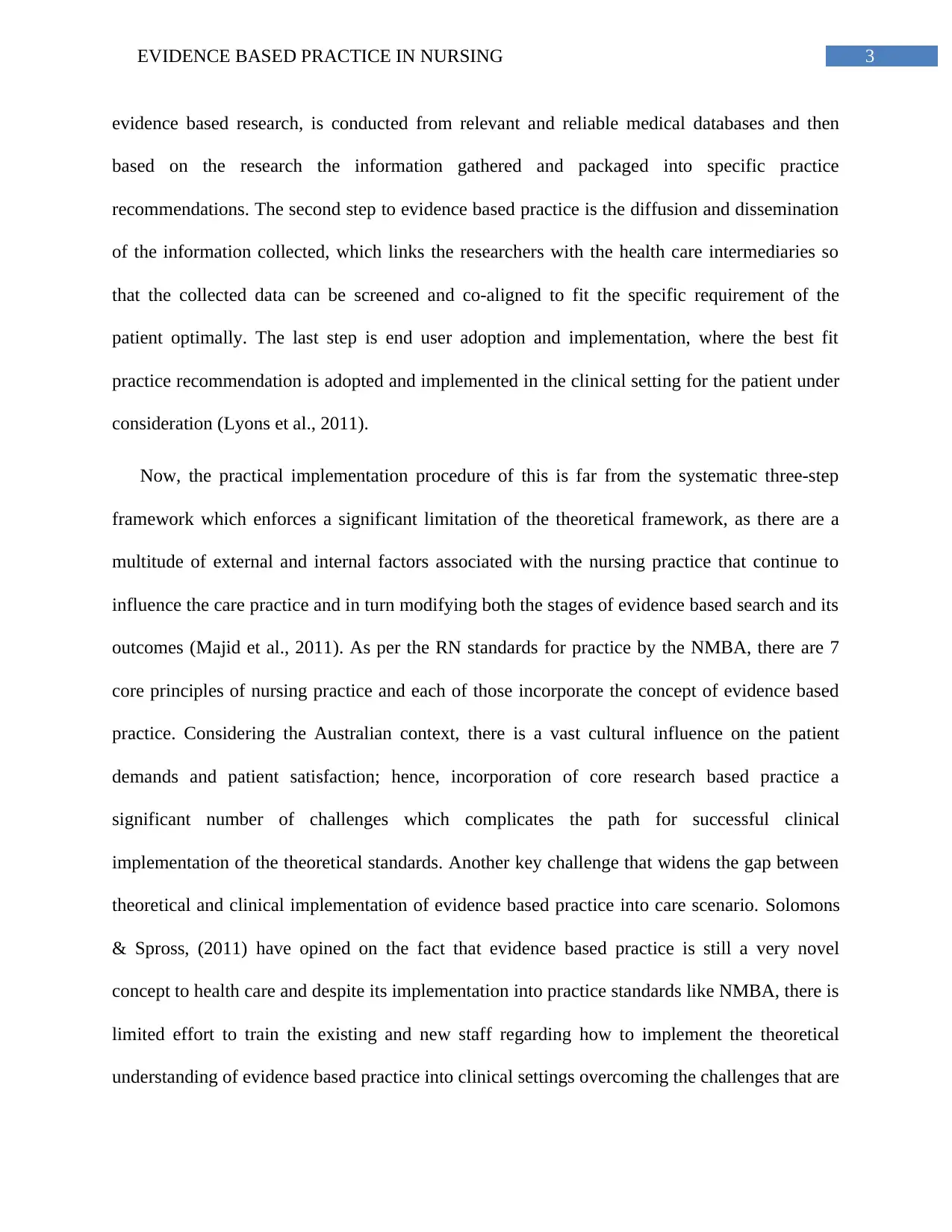
3EVIDENCE BASED PRACTICE IN NURSING
evidence based research, is conducted from relevant and reliable medical databases and then
based on the research the information gathered and packaged into specific practice
recommendations. The second step to evidence based practice is the diffusion and dissemination
of the information collected, which links the researchers with the health care intermediaries so
that the collected data can be screened and co-aligned to fit the specific requirement of the
patient optimally. The last step is end user adoption and implementation, where the best fit
practice recommendation is adopted and implemented in the clinical setting for the patient under
consideration (Lyons et al., 2011).
Now, the practical implementation procedure of this is far from the systematic three-step
framework which enforces a significant limitation of the theoretical framework, as there are a
multitude of external and internal factors associated with the nursing practice that continue to
influence the care practice and in turn modifying both the stages of evidence based search and its
outcomes (Majid et al., 2011). As per the RN standards for practice by the NMBA, there are 7
core principles of nursing practice and each of those incorporate the concept of evidence based
practice. Considering the Australian context, there is a vast cultural influence on the patient
demands and patient satisfaction; hence, incorporation of core research based practice a
significant number of challenges which complicates the path for successful clinical
implementation of the theoretical standards. Another key challenge that widens the gap between
theoretical and clinical implementation of evidence based practice into care scenario. Solomons
& Spross, (2011) have opined on the fact that evidence based practice is still a very novel
concept to health care and despite its implementation into practice standards like NMBA, there is
limited effort to train the existing and new staff regarding how to implement the theoretical
understanding of evidence based practice into clinical settings overcoming the challenges that are
evidence based research, is conducted from relevant and reliable medical databases and then
based on the research the information gathered and packaged into specific practice
recommendations. The second step to evidence based practice is the diffusion and dissemination
of the information collected, which links the researchers with the health care intermediaries so
that the collected data can be screened and co-aligned to fit the specific requirement of the
patient optimally. The last step is end user adoption and implementation, where the best fit
practice recommendation is adopted and implemented in the clinical setting for the patient under
consideration (Lyons et al., 2011).
Now, the practical implementation procedure of this is far from the systematic three-step
framework which enforces a significant limitation of the theoretical framework, as there are a
multitude of external and internal factors associated with the nursing practice that continue to
influence the care practice and in turn modifying both the stages of evidence based search and its
outcomes (Majid et al., 2011). As per the RN standards for practice by the NMBA, there are 7
core principles of nursing practice and each of those incorporate the concept of evidence based
practice. Considering the Australian context, there is a vast cultural influence on the patient
demands and patient satisfaction; hence, incorporation of core research based practice a
significant number of challenges which complicates the path for successful clinical
implementation of the theoretical standards. Another key challenge that widens the gap between
theoretical and clinical implementation of evidence based practice into care scenario. Solomons
& Spross, (2011) have opined on the fact that evidence based practice is still a very novel
concept to health care and despite its implementation into practice standards like NMBA, there is
limited effort to train the existing and new staff regarding how to implement the theoretical
understanding of evidence based practice into clinical settings overcoming the challenges that are
Paraphrase This Document
Need a fresh take? Get an instant paraphrase of this document with our AI Paraphraser
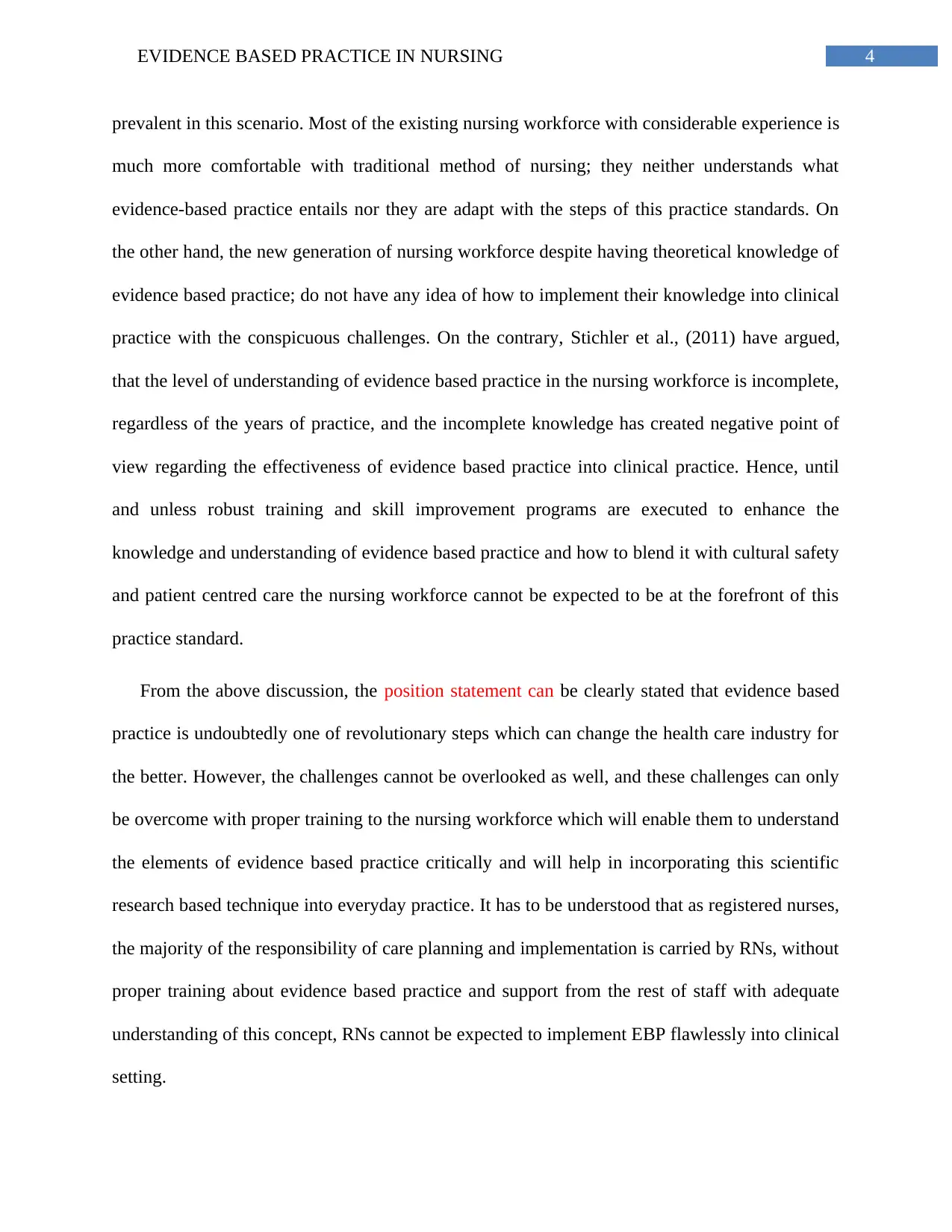
4EVIDENCE BASED PRACTICE IN NURSING
prevalent in this scenario. Most of the existing nursing workforce with considerable experience is
much more comfortable with traditional method of nursing; they neither understands what
evidence-based practice entails nor they are adapt with the steps of this practice standards. On
the other hand, the new generation of nursing workforce despite having theoretical knowledge of
evidence based practice; do not have any idea of how to implement their knowledge into clinical
practice with the conspicuous challenges. On the contrary, Stichler et al., (2011) have argued,
that the level of understanding of evidence based practice in the nursing workforce is incomplete,
regardless of the years of practice, and the incomplete knowledge has created negative point of
view regarding the effectiveness of evidence based practice into clinical practice. Hence, until
and unless robust training and skill improvement programs are executed to enhance the
knowledge and understanding of evidence based practice and how to blend it with cultural safety
and patient centred care the nursing workforce cannot be expected to be at the forefront of this
practice standard.
From the above discussion, the position statement can be clearly stated that evidence based
practice is undoubtedly one of revolutionary steps which can change the health care industry for
the better. However, the challenges cannot be overlooked as well, and these challenges can only
be overcome with proper training to the nursing workforce which will enable them to understand
the elements of evidence based practice critically and will help in incorporating this scientific
research based technique into everyday practice. It has to be understood that as registered nurses,
the majority of the responsibility of care planning and implementation is carried by RNs, without
proper training about evidence based practice and support from the rest of staff with adequate
understanding of this concept, RNs cannot be expected to implement EBP flawlessly into clinical
setting.
prevalent in this scenario. Most of the existing nursing workforce with considerable experience is
much more comfortable with traditional method of nursing; they neither understands what
evidence-based practice entails nor they are adapt with the steps of this practice standards. On
the other hand, the new generation of nursing workforce despite having theoretical knowledge of
evidence based practice; do not have any idea of how to implement their knowledge into clinical
practice with the conspicuous challenges. On the contrary, Stichler et al., (2011) have argued,
that the level of understanding of evidence based practice in the nursing workforce is incomplete,
regardless of the years of practice, and the incomplete knowledge has created negative point of
view regarding the effectiveness of evidence based practice into clinical practice. Hence, until
and unless robust training and skill improvement programs are executed to enhance the
knowledge and understanding of evidence based practice and how to blend it with cultural safety
and patient centred care the nursing workforce cannot be expected to be at the forefront of this
practice standard.
From the above discussion, the position statement can be clearly stated that evidence based
practice is undoubtedly one of revolutionary steps which can change the health care industry for
the better. However, the challenges cannot be overlooked as well, and these challenges can only
be overcome with proper training to the nursing workforce which will enable them to understand
the elements of evidence based practice critically and will help in incorporating this scientific
research based technique into everyday practice. It has to be understood that as registered nurses,
the majority of the responsibility of care planning and implementation is carried by RNs, without
proper training about evidence based practice and support from the rest of staff with adequate
understanding of this concept, RNs cannot be expected to implement EBP flawlessly into clinical
setting.
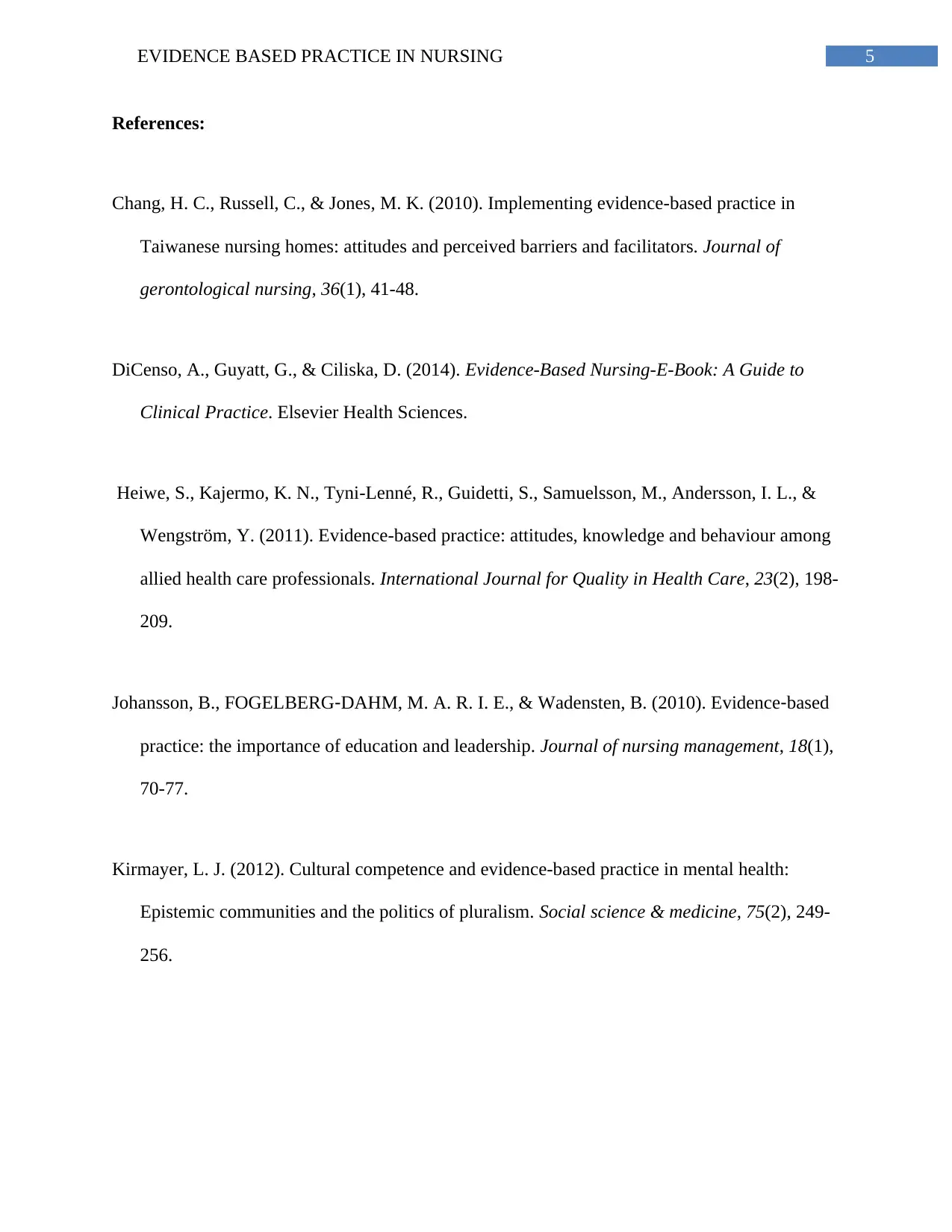
5EVIDENCE BASED PRACTICE IN NURSING
References:
Chang, H. C., Russell, C., & Jones, M. K. (2010). Implementing evidence-based practice in
Taiwanese nursing homes: attitudes and perceived barriers and facilitators. Journal of
gerontological nursing, 36(1), 41-48.
DiCenso, A., Guyatt, G., & Ciliska, D. (2014). Evidence-Based Nursing-E-Book: A Guide to
Clinical Practice. Elsevier Health Sciences.
Heiwe, S., Kajermo, K. N., Tyni-Lenné, R., Guidetti, S., Samuelsson, M., Andersson, I. L., &
Wengström, Y. (2011). Evidence-based practice: attitudes, knowledge and behaviour among
allied health care professionals. International Journal for Quality in Health Care, 23(2), 198-
209.
Johansson, B., FOGELBERG‐DAHM, M. A. R. I. E., & Wadensten, B. (2010). Evidence‐based
practice: the importance of education and leadership. Journal of nursing management, 18(1),
70-77.
Kirmayer, L. J. (2012). Cultural competence and evidence-based practice in mental health:
Epistemic communities and the politics of pluralism. Social science & medicine, 75(2), 249-
256.
References:
Chang, H. C., Russell, C., & Jones, M. K. (2010). Implementing evidence-based practice in
Taiwanese nursing homes: attitudes and perceived barriers and facilitators. Journal of
gerontological nursing, 36(1), 41-48.
DiCenso, A., Guyatt, G., & Ciliska, D. (2014). Evidence-Based Nursing-E-Book: A Guide to
Clinical Practice. Elsevier Health Sciences.
Heiwe, S., Kajermo, K. N., Tyni-Lenné, R., Guidetti, S., Samuelsson, M., Andersson, I. L., &
Wengström, Y. (2011). Evidence-based practice: attitudes, knowledge and behaviour among
allied health care professionals. International Journal for Quality in Health Care, 23(2), 198-
209.
Johansson, B., FOGELBERG‐DAHM, M. A. R. I. E., & Wadensten, B. (2010). Evidence‐based
practice: the importance of education and leadership. Journal of nursing management, 18(1),
70-77.
Kirmayer, L. J. (2012). Cultural competence and evidence-based practice in mental health:
Epistemic communities and the politics of pluralism. Social science & medicine, 75(2), 249-
256.
⊘ This is a preview!⊘
Do you want full access?
Subscribe today to unlock all pages.

Trusted by 1+ million students worldwide
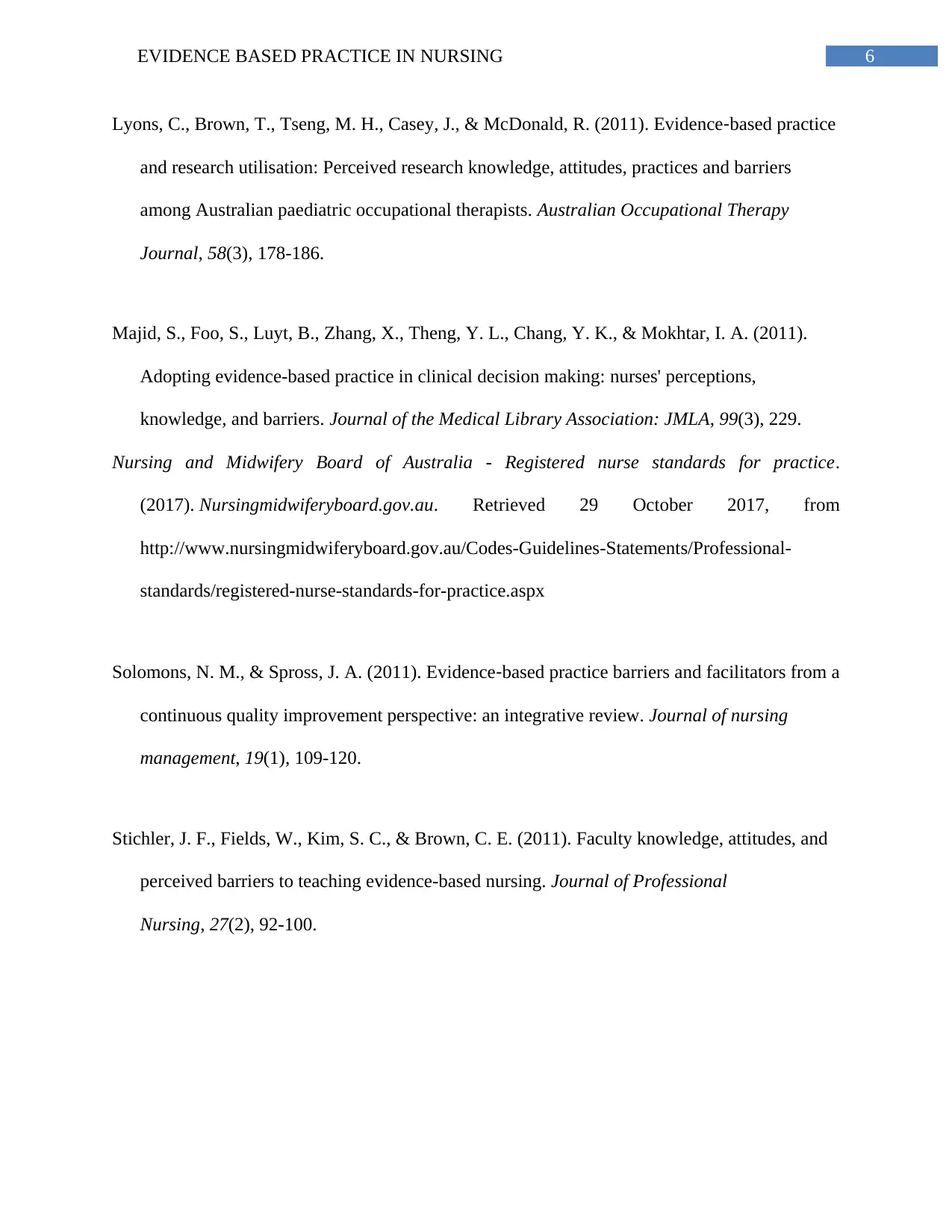
6EVIDENCE BASED PRACTICE IN NURSING
Lyons, C., Brown, T., Tseng, M. H., Casey, J., & McDonald, R. (2011). Evidence‐based practice
and research utilisation: Perceived research knowledge, attitudes, practices and barriers
among Australian paediatric occupational therapists. Australian Occupational Therapy
Journal, 58(3), 178-186.
Majid, S., Foo, S., Luyt, B., Zhang, X., Theng, Y. L., Chang, Y. K., & Mokhtar, I. A. (2011).
Adopting evidence-based practice in clinical decision making: nurses' perceptions,
knowledge, and barriers. Journal of the Medical Library Association: JMLA, 99(3), 229.
Nursing and Midwifery Board of Australia - Registered nurse standards for practice.
(2017). Nursingmidwiferyboard.gov.au. Retrieved 29 October 2017, from
http://www.nursingmidwiferyboard.gov.au/Codes-Guidelines-Statements/Professional-
standards/registered-nurse-standards-for-practice.aspx
Solomons, N. M., & Spross, J. A. (2011). Evidence‐based practice barriers and facilitators from a
continuous quality improvement perspective: an integrative review. Journal of nursing
management, 19(1), 109-120.
Stichler, J. F., Fields, W., Kim, S. C., & Brown, C. E. (2011). Faculty knowledge, attitudes, and
perceived barriers to teaching evidence-based nursing. Journal of Professional
Nursing, 27(2), 92-100.
Lyons, C., Brown, T., Tseng, M. H., Casey, J., & McDonald, R. (2011). Evidence‐based practice
and research utilisation: Perceived research knowledge, attitudes, practices and barriers
among Australian paediatric occupational therapists. Australian Occupational Therapy
Journal, 58(3), 178-186.
Majid, S., Foo, S., Luyt, B., Zhang, X., Theng, Y. L., Chang, Y. K., & Mokhtar, I. A. (2011).
Adopting evidence-based practice in clinical decision making: nurses' perceptions,
knowledge, and barriers. Journal of the Medical Library Association: JMLA, 99(3), 229.
Nursing and Midwifery Board of Australia - Registered nurse standards for practice.
(2017). Nursingmidwiferyboard.gov.au. Retrieved 29 October 2017, from
http://www.nursingmidwiferyboard.gov.au/Codes-Guidelines-Statements/Professional-
standards/registered-nurse-standards-for-practice.aspx
Solomons, N. M., & Spross, J. A. (2011). Evidence‐based practice barriers and facilitators from a
continuous quality improvement perspective: an integrative review. Journal of nursing
management, 19(1), 109-120.
Stichler, J. F., Fields, W., Kim, S. C., & Brown, C. E. (2011). Faculty knowledge, attitudes, and
perceived barriers to teaching evidence-based nursing. Journal of Professional
Nursing, 27(2), 92-100.
1 out of 7
Related Documents
Your All-in-One AI-Powered Toolkit for Academic Success.
+13062052269
info@desklib.com
Available 24*7 on WhatsApp / Email
![[object Object]](/_next/static/media/star-bottom.7253800d.svg)
Unlock your academic potential
Copyright © 2020–2025 A2Z Services. All Rights Reserved. Developed and managed by ZUCOL.




